SUMMER 2024
The Empire of the Ants
They might make you wriggle and squirm, but three UP scientists are here to tell you that these remarkable critters are worth looking at under a microscope.
- Story by Cheston Knapp
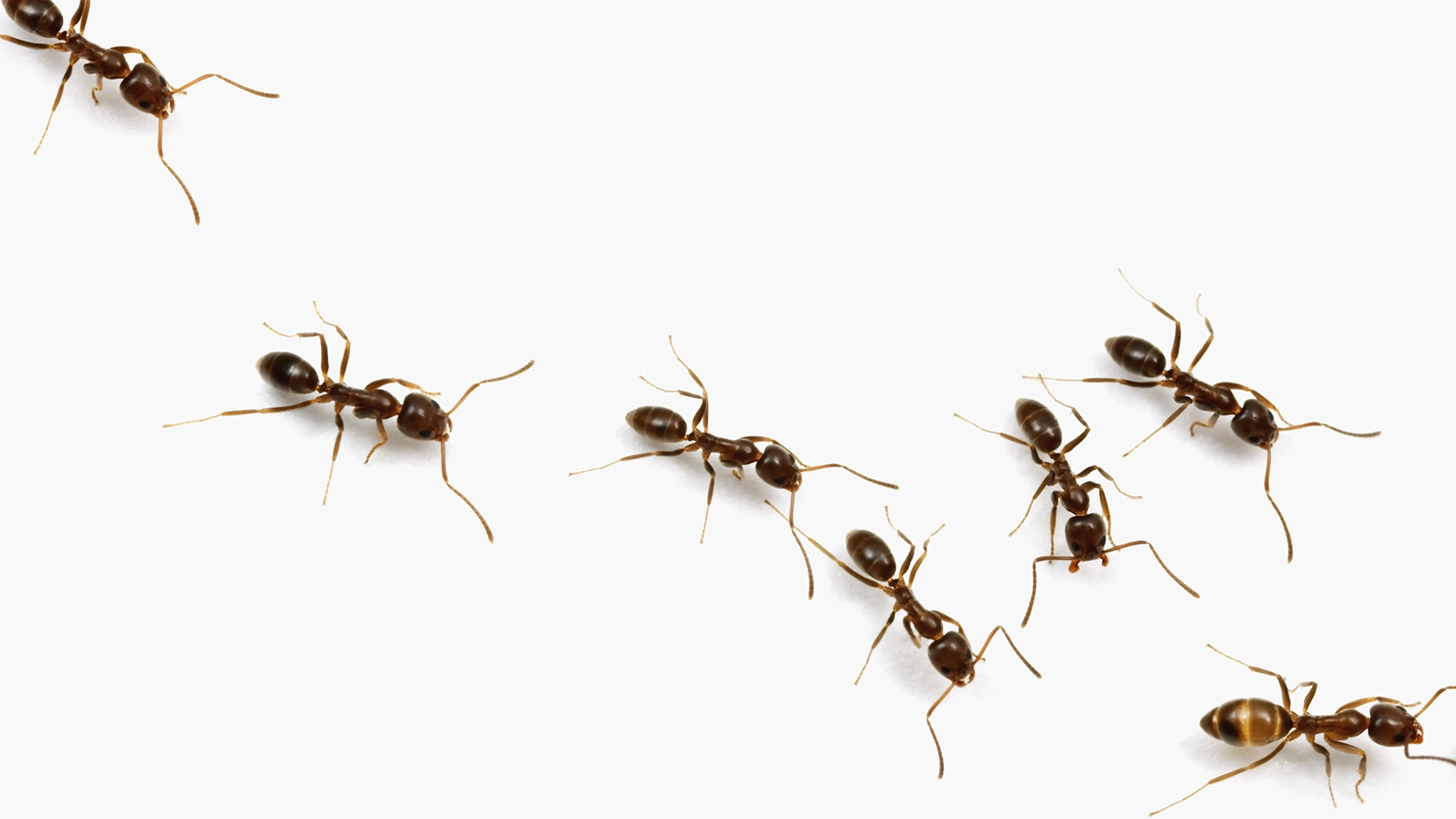
Argentine Ants (All photos by Alex Wild)
LET’S GET SMALL.
Ants range in size from less than one millimeter to roughly two inches long, that is, from smaller than the tip of a sharpened pencil to two meaty paperclips. They’re insects, of course, arguably the most famous, which means they have six legs and a body composed of three segments: head, thorax, and abdomen. Like bees and wasps, their cousins in the Order Hymenoptera, ants have five eyes (two compound and three simple), but don’t let that hardware fool you—they see about as well as Mr. Magoo. Some, however, can discern color. Sprouting from their heads you’ll find their adorable antennae, which aren’t ears, but sophisticated noses that help give them their superpower: smell-o-vision. They use these olfactory wands to navigate, communicate, detect enemies, groom themselves, and, in some species, whip each other in ritualistic duels. Ants “hear” with a special gland found in their legs and they “breathe” through tiny eyelets that cover their bodies. They have two stomachs, one for themselves and one for sharing food with nestmates through an icky process called trophallaxis (barfing). Honeypot ants have evolved a special caste called the “replete,” which stores communal food in themselves, eating so much that their stomachs swell to amber globules the size of a champagne grape—remarkable generosity for a creature that’s literally heartless. Around ants’ mouths you’ll find their horrifying, scissor-like jaws, called mandibles. They use these to manipulate objects, gnaw through leaves, and capture or kill prey. Some trap-jaw ants can snap their mandibles shut at 145 mph, which is more than 200 feet per second, or ten times faster than a guillotine falls. While all ants can bite, some species have evolved more treacherous weaponry, like venomous stingers and skunk-like glands that can squirt caustic acid. Famously brawny, an ant’s brain is, on average, this big: *.
Lowly and commonplace creatures, these minikins are nonetheless one of evolution’s most successful experiments. Scientists have identified more than 15,000 species and sub-species and some believe that there are as many more out there waiting to be discovered. For every person on Earth, according to one conservative estimate, there are at least 2.5 million ants. Nature wriggles, squirms, and bristles with them. For the squeamish among us, ants represent some unholy mix of madness, disease, and death, and the thought of them electrifies the hair on our arms and necks, makes our skin crawl. But they don’t give everyone the fantods. For scientists like Valerie Banschbach, PhD, and Sam Schwartz ’26, ants are bewitching critters. They’re the primary engineers of their ecosystems and for those undaunted souls who have the ears to hear them, they tell rich and rewarding stories about the health of their biomes.
“People think ants just show up to ruin picnics and eat your cat food,” Valerie told me on a recent visit. “Not everyone gets to look at them under the microscope.”
We’d met in her office, in part, so I could survey her assortment of pinned ants, a collection she’s assembled on trips to Costa Rica, Uganda, and back in Vermont, where she taught before becoming the Dean of UP’s College of Arts and Sciences. A lover of all insects, Valerie first wanted to show off her dreamier specimens, arrayed in glass-topped wooden display cases. There was an armada of iridescent orchid bees that had long, whiplike proboscises. There were hirsute moths as shaggy as sheepdogs pinned next to parti-colored butterflies. There was a shiny green beetle with a carapace of hammered gold that looked like a shield fashioned by a fairy blacksmith. All these bugs were so stunning, so enchanting, that it was easy to understand how someone could devote their life to thinking about them. But the bulk of Valerie’s collection lives in dozens of non-descript white cardboard boxes of the sort you’d use to store baseball cards or slides from your grandparents’ vacations. She opened one to reveal a matrix of atomic black specks, each one affixed to a long pin. It looked like the starting grid of the old game Dots and Boxes. Some of the ants were hardly bigger than a chocolate sprinkle, and I marveled at the manual dexterity of the person who’d pinned them. And there were so many! Glancing at the other boxes, I figured her collection must be in the ballpark of 10,000. Accompanying each ant was an info tag bearing the species name, where and when they were found, how they were collected, and more. What they lacked in visual splendor, they more than made up for in their sheer abundance. If you took all the ants off their pins, I thought, you could probably fill a maraca. As she explained a handful of the species, Valerie exuded a contagious enjoyment, and an obvious truth became clear during our conversation: a single ant is a paltry thing, but taken together, they shine. E pluribus unum.
“Instead of the colony living together in one rotted out stick, these ants split up and get apartments nearby,” she said of one species. “It’s the cutest thing—you’ll pick up an acorn and find a dozen or more little ants inside, just going about their business.”
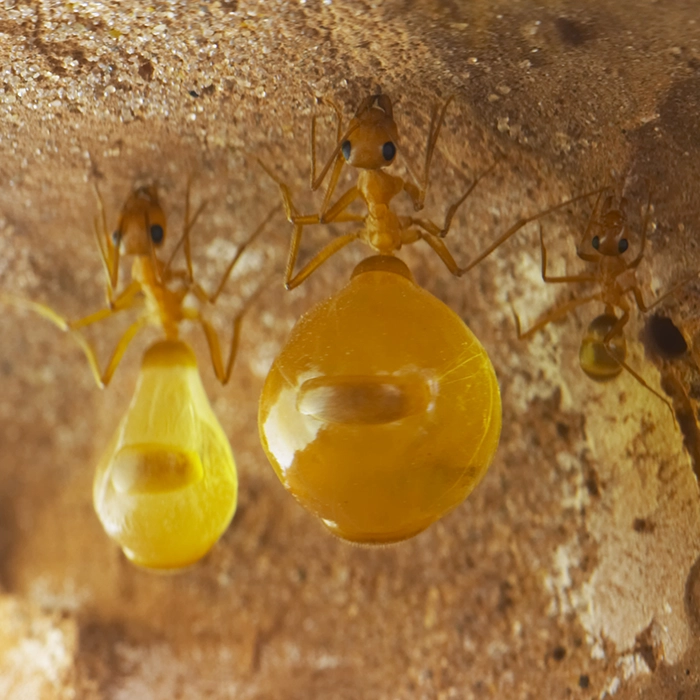
Honeypot Ants
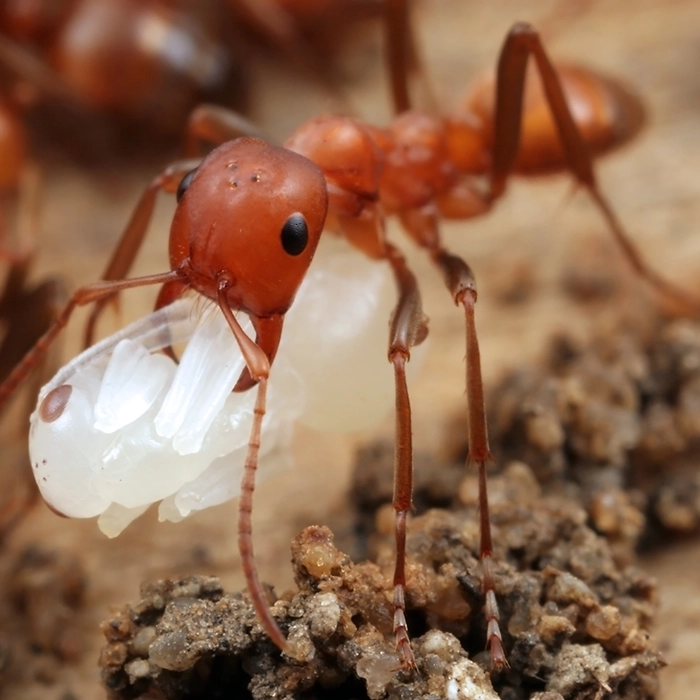
Amazon Ant
While Valerie has been fascinated by complex animal behavior since she was a girl, after reading about Jane Goodall’s work with the great apes, her path to ants was circuitous. They weren’t her first love. In graduate school, she worked with honeybees, investigating the intricate ways they communicate. For her dissertation, she sat in a small room with ten thousand bees and paid frightfully close attention to how they conducted themselves after she released droplets of ambrosial nectar into artificial flowers. But this experiment came with unsurprising occupational hazards.
“I got stung a lot,” she said, ruefully. “I ended up developing a bad allergy and had to carry an EpiPen around.”
With her dissertation complete, she found herself at an impasse, needing to shift gears. Fortune smiled on her when she learned about a post-doctorate grant to study ants in Vermont. Like bees, ants are what scientists call “eusocial” (i.e., “truly social”) creatures. This means that they form complex societies that cooperate to care for a shared brood, have overlapping generations in one shelter, and distribute labor among the colony along reproductive and non-reproductive lines, with a fertile queen and non-fertile workers and foragers. They typify the all for one and one for all ethos that constitutes the highest form of social organization.
“The evolutionary leap to highly complex societies has occurred only two dozen times,” Valerie said. “And ants are one.” Like humans, ants owe their phenomenal success to the fact that they talk so well. With up to fifty different pheromones, along with haptic social cues, like prodding one another with their antennae, they can convey a staggering range of information. This allows ants to work together to accomplish extraordinary things, so extraordinary that scientists consider them a superorganism.
Leafcutter ants farm mushrooms. Herder ants keep livestock in the form of caterpillars and aphids. African Driver ants are nomadic, living in temporary bivouacs made of their own bodies, and can bring down prey as hefty as a small chicken. Weaver ants build bridges to connect trees, enabling outposts far away from the queen’s central nest, and their colonies can grow to cover an area roughly the size of four basketball courts. Amazon ants specialize in raiding other ants’ nests and making slaves of those they capture, which they accomplish by employing a “propaganda” pheromone that confuses the ants they’re raiding. During her time in the forests of Vermont, Valerie discovered that one ant species uses tools, a high-water mark of evolutionary sophistication. She set out small petri dishes of bait and found that these ants would drop bits of leaves and sticks in the jelly, soaking up as much as they could before returning to their nest with their haul.
“This species, their bodies aren’t suited to hold a lot of food,” she said. “So they carry a bag!”
For most of us, watching ants go about their pestilential business is like listening to radio static.“Where—Oh where— / Are You scurrying?” we wonder, with Emily Dickinson. But myrmecologists like Valerie can find the frequency. And she’s been delighted to find something of a protégé in Sam Schwartz, who can also hear the music.
“Sometimes I look down at the ants and I feel like I understand them,” Sam said, on a recent tour of the ant colonies he’s found on The Bluff. “I just get them.”
Sam grew up in Texas and Washington and has loved ants for as far back as he can remember. And maybe even longer. When his mother was pregnant with Sam—goes his Marvel-style origin-story—she ran over a wasp nest while mowing the lawn and was stung more than eighty times.
“I like to joke I have the DNA for this,” he said, and his eyes smiled behind his half-dark transition lenses.
He traces his academic interest in ants back to a project he did in middle school about the yellow crazy ant infestation on Christmas Island, off the coast of Australia. Accidentally introduced into the ecosystem, this invasive species disrupts one of the most spectacular events on Earth, the migration of the red crab. As the crabs meander from the forest, in the island’s center, down to the sea to mate, they run afoul of the ants, who spritz formic acid in their eyes and on their joints, which blinds and immobilizes them. They ultimately die of dehydration. And similar ecological disruptions are happening all over the world because of non-native ants like this. Thanks in part to low genetic diversity, these ants don’t compete with one another, as typically happens. They cooperate, combining forces to form what are called supercolonies, with fertile queens spread across many different nests. Without other groups to fight and thereby thin the herds of both, they spread, sometimes on improbable and staggering scales. One super-colony of Argentine ants has settlements in California, Europe, Japan, New Zealand, and Australia, an intercontinental reach reminiscent of the great empires. Learning this makes you wonder what people could accomplish if we—country, class, or species—woke up one morning having forgotten why we hate each other.
“I’ve tried to find a way to write about ants in every class since that project,” Sam said. “I’m fascinated by the parallels between ants and humans.”
At the moment, he’s working with Glenna Clifton, assistant professor of biology, on a multi-year experiment that tests what kind of surface ants prefer to walk over. His first task was to find where they live on campus. On our walk, he took me to a parking lot outside Kenna Hall, where the ants congregate under a curb stop; to the bluff side of The Commons, where they’ve posted up in the mortar of a brick wall and at the base of a large tree; to the front of LP Tennis Center, where they emerge from the base of the foundation; to the north side of Mehling Hall, which will come as no surprise to residents past and present; and to a flower bed outside of Fields Hall. Sam was excited to spend more time down on the Franz River Campus, where he expects to find a wealth of activity now that construction has settled down.
“Sam is such an enthusiastic ant scientist,” Glenna said. “I wanted to develop a project that spoke to his interests and that I could help with.”
Glenna works in a field called comparative biomechanics, which means she studies how animals move, a fitting pursuit for someone who grew up doing elite ballet. After receiving her PhD from Harvard, where she worked on aquatic birds like grebes and loons, she received a postdoctoral fellowship to study the way Argentine ants move over different terrains. Because her field draws from so many disciplines, she’s become a magnet for ambitious students interested in pursuing independent experiments, lab work that takes them slightly off the beaten track.
“It leads to a lot of failure, which is really helpful,” she said. “Most experiments don’t end how you expect, so a lot of the mentoring I do is asking ‘Is it good enough and how do you know?’ or ‘How much failure are you ok with?’”
Sam began his project a year ago, and, from the start, encountered plenty of learning experiences. His cameras acted up. The ants wouldn’t cooperate. At one point he was only sleeping three hours a night, waking before the sun to make sure everything was ready for the day ahead.
“I spent most of last summer debugging the experiment,” he said, laughing. “But I’m ready to hit the ground running this year.”
Sam is using many of the techniques that Glenna developed during her postdoctoral work, including robust digital imaging and machine-learning software that helps them track the ants’ movement. As he took me through his experiment, which seemed incredibly complex, I was struck by how much science is like a superorganism. Like ant colonies, it requires small units working together to produce a living and growing body of knowledge.
“Sam has a calling,” Valerie said. “He’s not only passionate about ants, but he’s also thinking about his career.”
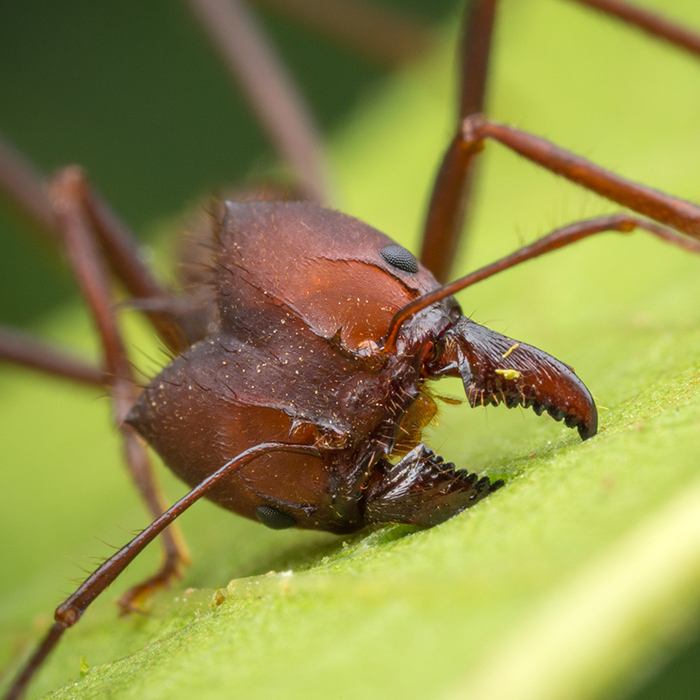
Leafcutter ant
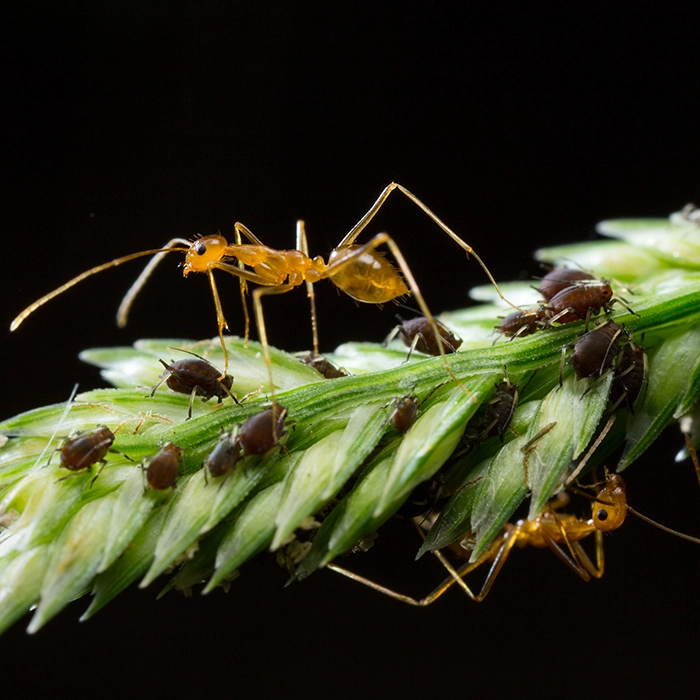
Yellow crazy ants
Given Sam’s love of ants, his career ambitions might seem ironic: he wants to go into the business of killing them. That is, he hopes to work in pesticides.
“We’re fighting a war with ants,” he said. “And we’re losing.” Invasive species like the yellow crazy ant are a common occurrence—during the pandemic, Sam wrote a forty-page paper about the raspberry crazy ant infestation in Florida—and they can reduce the natural biodiversity of a region, which has knock-on negative effects. And Sam has strong opinions about eradication strategies for what he calls “species of mass destruction.” It’s common knowledge that the best pesticides are the worst for the environment, so scientists have been working on more effective methods, including the use of microsporidians (parasitic fungi) and parasitoid wasps or other natural predators that have evolved to eat a single species. As promising as those options are, Sam believes the future is in pheromones, including adding them to smaller doses of pesticide to make them more effective or something more creative.
“Have you ever heard of a death spiral?” he asked.
In response to my inquisitive silence, he explained that it’s when a group of ants gets caught marching in an endless circle, often resulting in death from exhaustion. One ant loses the scent and veers off, laying down an aberrant pheromone trail, which creates a feedback loop, with the ants behind her following blindly. The possibility of manipulating pheromones to induce such a response really revs up Sam’s mental engine. Perhaps that way lies the future of pesticides.
The more you read about ants, the more tempting it is to anthropomorphize them, to pick out the “parallels” that Sam mentioned. But then you hear about a thing like the death spiral and you can rest easy in a giddy sense of superiority. Right? Humans do plenty of silly things, but we’re better than that. We’re self-aware, after all. We would never let one person lead us astray, down a path toward certain doom. We don’t form teeming hordes who blindly follow the deranged whims of a fatuous influencer. We’re not susceptible to groupthink, deceitful language, and faulty information. Oh, wait…
“Colonies get these emergent properties because there are all these fairly simple cues that individuals base decisions on,” Valerie said. By emergent she means, simply, that the whole is more than the sum of its parts. Groups of ants have far more complex characteristics than any one ant, and this has led her to compare them to Artificial Intelligence, and, by implication, to consciousness.
Over and over again, ants give the lie to the idea that anything we do, as humans, is special. They’re incredibly smart, use tools, and have a language that’s practically syntactical. And their capacity for collective intelligence rivals, if not exceeds, our own. Against all the evidence of our similarities, we cling to the notion of our uniqueness, our precious and curated “personalities.” Eerily enough, though, some scientists claim to have demonstrated that ants pass the mirror test, an experiment designed to uncover the most basic form of self-awareness. When put in front of a mirror, they, individual ants, alone, recognize themselves—Anthony, Samantha, Grant, Antigone.… It’s an elite crew to be a part of, including Asian elephants, orcas, bottlenose dolphins, orangutans, bonobos, chimpanzees, and Eurasian magpies. That they survived the dinosaurs—and that we know, deep down, that they’ll survive us—only makes them more humbling. And that’s the lesson ants teach us ad nauseum: humility. You see them best, after all, down on your knees.
CHESTON KNAPP is Portland magazine’s senior writer and associate editor.